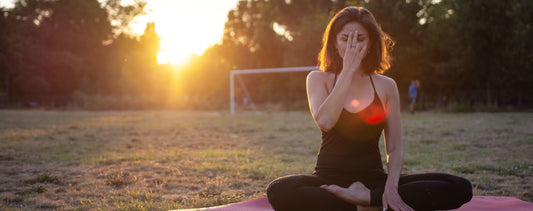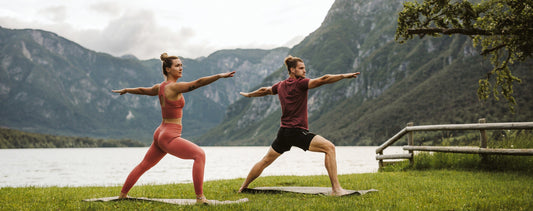Take a moment and focus on your breath. What do you notice?
We unconsciously hold our breath many times each day. It’s typically the first action that we take when we don’t want to lose control of a situation. This is a normal reflex; we reduce our breathing to a survival level when we’re tense and trying to just “get through it.” We take in just enough oxygen to stay alive. Vigorous exercise may be the only time when we truly and deeply breathe.
We should be doing the exact opposite. Studies have shown that yoga and pranayama can help to reduce stress, relieve tension in the body, help improve the immune system, and support better sleep. Breathing techniques and yoga postures, including belly and rhythmic breathing as well as the child’s pose, will help you relax and reduce stress. These exercises are simple, don’t take much time, require no equipment, and can be done anywhere. Try each and see how they affect your stress and anxiety levels.
This is a core breath that is used at the beginning of most yoga classes. It can bring awareness into the body and calm the mind.
Rhythmic Breathing
This is a more energizing breath. Use this if you’re feeling sluggish or disconnected from your body and need more energy. This is a good alternative to drinking another cup of coffee.
Nadi Shodhana (Alternate Nostril Breathing)
This breath is great for releasing tension and balancing the left and right hemispheres of the brain. Try this breath before meditating or just before going to sleep. It helps to quiet the mind.
Practicing these three breathing techniques can help eliminate stress, which slows down aging, and can even prevent illness.
This posture calms the mind and helps to relieve back, neck, shoulder, and hip tension. This powerful yet gentle pose provides mental, physical, and emotional relief.
This posture has so many great applications and benefits. Even if you don’t have menstrual pain, sciatica, gastritis, osteoporosis, or anxiety, this pose can help reduce stress hormones and elevate your mood. The entire body is stretched in this pose. It also provides mental calmness because the head is slightly lower than the heart.
This is the ultimate relaxation pose. Beta brain waves are decreased and the central nervous system is relaxed; the entire mind/body benefits from this pose. It’s why every yoga class ends with Savasana.
- Are you holding it?
- Are you taking shallow breaths?
- Is your breathing heavy and labored?
We unconsciously hold our breath many times each day. It’s typically the first action that we take when we don’t want to lose control of a situation. This is a normal reflex; we reduce our breathing to a survival level when we’re tense and trying to just “get through it.” We take in just enough oxygen to stay alive. Vigorous exercise may be the only time when we truly and deeply breathe.
We should be doing the exact opposite. Studies have shown that yoga and pranayama can help to reduce stress, relieve tension in the body, help improve the immune system, and support better sleep. Breathing techniques and yoga postures, including belly and rhythmic breathing as well as the child’s pose, will help you relax and reduce stress. These exercises are simple, don’t take much time, require no equipment, and can be done anywhere. Try each and see how they affect your stress and anxiety levels.
Just Breathe
Belly BreathingThis is a core breath that is used at the beginning of most yoga classes. It can bring awareness into the body and calm the mind.
- Gently close your eyes and sit comfortably or lie down with the spine straight. Relax your hands in your lap or rest your arms next at your sides with the palms facing up.
- Inhale through the nose and allow the belly to expand.
- Exhale through the nose and allow the belly to lower.
Rhythmic Breathing
This is a more energizing breath. Use this if you’re feeling sluggish or disconnected from your body and need more energy. This is a good alternative to drinking another cup of coffee.
- Eyes can be open or closed. Perform this while standing, kneeling, or walking.
- Inhale through the nose twice in quick, short succession.
- Exhale through the nose twice in quick, short succession.
- Repeat. That’s it. Inhale, inhale, exhale, exhale.
Nadi Shodhana (Alternate Nostril Breathing)
This breath is great for releasing tension and balancing the left and right hemispheres of the brain. Try this breath before meditating or just before going to sleep. It helps to quiet the mind.
- Sit comfortably with spine erect. Eyes can be open or closed.
- Gently rest the first two fingers of the right hand on your forehead—just between your eyebrows.
- Place the thumb of your right hand on you right nostril, closing it off.
- Inhale through your left nostril and hold the breath for just a moment. The mouth should be closed.
- Cover and hold the left nostril with the ring or fourth finger on your right hand.
- Release your thumb and exhale the breath through your right nostril.
- Inhale again through your right nostril while your fourth finger closes your left nostril.
- Cover and hold the right nostril with your thumb while you release your fourth finger from your left nostril and exhale.
- Repeat for as long as you like going back and forth as described above.
Practicing these three breathing techniques can help eliminate stress, which slows down aging, and can even prevent illness.
Strike a Pose
Child’s PoseThis posture calms the mind and helps to relieve back, neck, shoulder, and hip tension. This powerful yet gentle pose provides mental, physical, and emotional relief.
- Kneel on the mat or floor and bring the knees together and the buttocks toward the feet.
- Exhale slowly and rest your torso over your thighs, allowing the forehead to touch the mat.
- Extend the arms toward the front of the mat with the elbows bent and palms facing down.
- Take several deep breaths.
This posture has so many great applications and benefits. Even if you don’t have menstrual pain, sciatica, gastritis, osteoporosis, or anxiety, this pose can help reduce stress hormones and elevate your mood. The entire body is stretched in this pose. It also provides mental calmness because the head is slightly lower than the heart.
- Begin in Utthita Trikonasana (Extended Triangle Pose) against the wall.
- Place the bottom hand on the mat or on a block directly under the shoulder and in front of the bottom foot.
- Extend the top arm up and against the wall with the fingers extended and the palm facing outward.
- Extend the top leg up and against the wall with the foot flexed.
- Turn the face up and toward the ceiling. If this is uncomfortable for your neck, you can look straight ahead or at the ground.
- Take several deep breaths and then repeat on the opposite side.
This is the ultimate relaxation pose. Beta brain waves are decreased and the central nervous system is relaxed; the entire mind/body benefits from this pose. It’s why every yoga class ends with Savasana.
- Lying on your back on your yoga mat, press into the elbows to lift the back slightly and bring the shoulder blade back and down, dropping the shoulders away from the ears.
- Extend the arms out next to and away from the body with the palms facing up.
- Extend the legs out and away from each other, allowing the feet to drop out to the side.
- Soften the body and mind and relax into the floor.






















